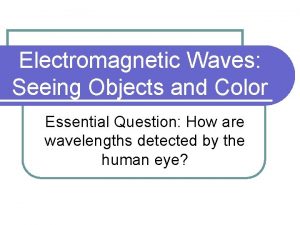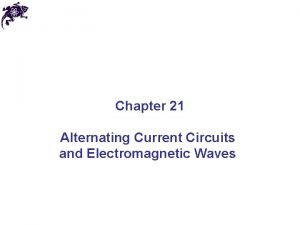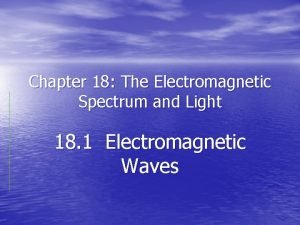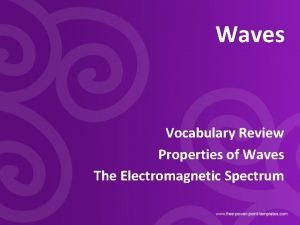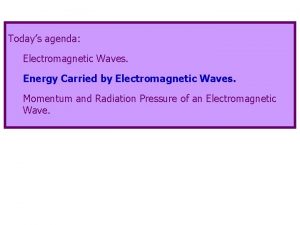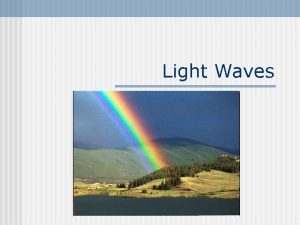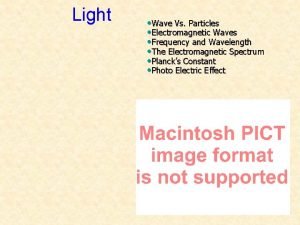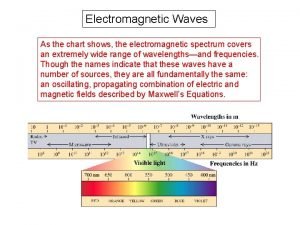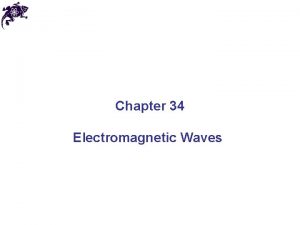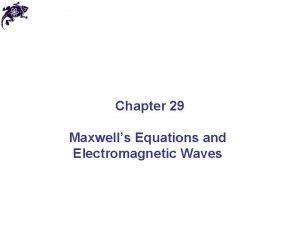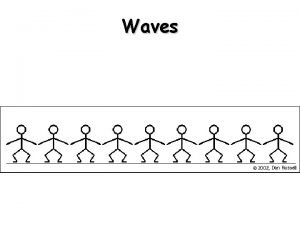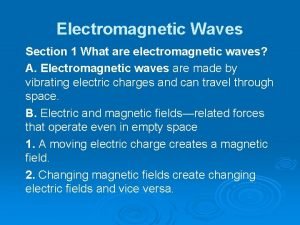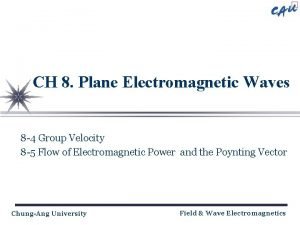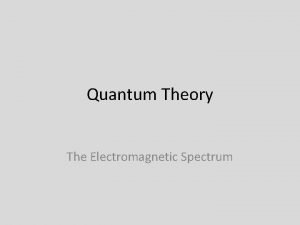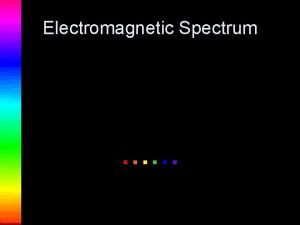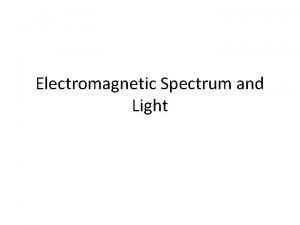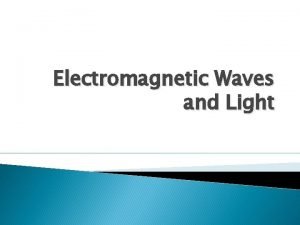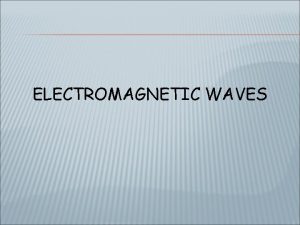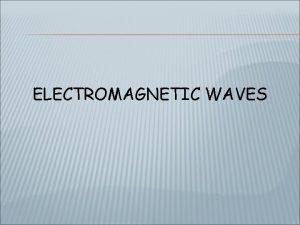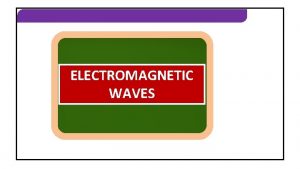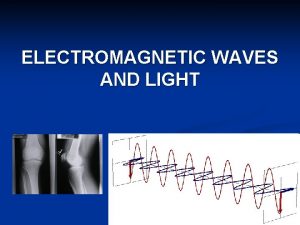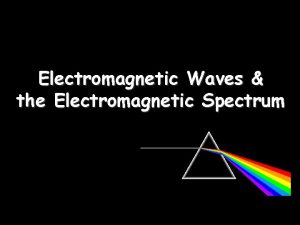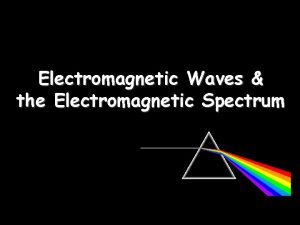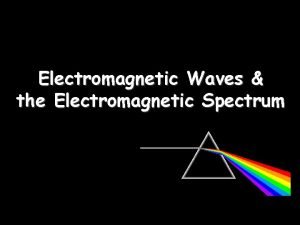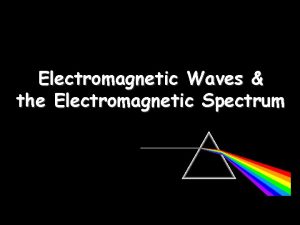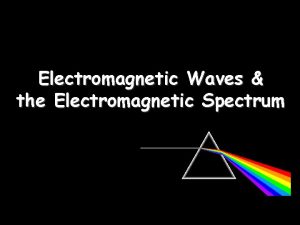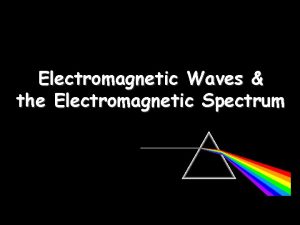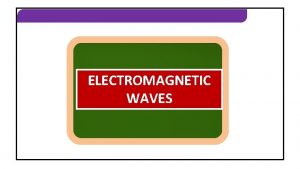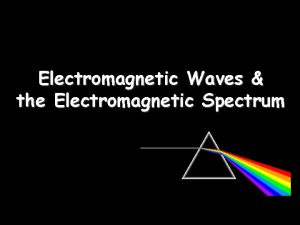ELECTROMAGNETIC WAVES AND LIGHT ELECTROMAGNETIC WAVES Electromagnetic Waves





























- Slides: 29

ELECTROMAGNETIC WAVES AND LIGHT

ELECTROMAGNETIC WAVES Electromagnetic Waves travel through empty space or through matter and are produced by charged particles that are in motion.

ELECTROMAGNETIC WAVES ØThey are transverse and non-mechanical waves. ØElectromagnetic waves are produced by charged particles, such as electrons, that move back and forth or vibrate. ØAs a charged particle vibrates by moving up and down or back and forth, it produces changing electric and magnetic fields that move away from the vibrating charge in many directions.

Ø These changing fields travel in many directions. Ø They form an electromagnetic wave.

PARTICLE OR WAVE? Light can • Behave as a particle called a PHOTON – whose energy depends on the frequency of light. • Behave as a wave – whose energy depends on its frequency.

PROPERTIES OF EM WAVES ØElectromagnetic waves have a wavelength and a frequency. ØOne complete vibration of the charged particle up and down creates one wavelength. ØThe number of wavelengths that pass by a point in one second is the frequency of the electromagnetic wave and is measured in hertz, Hz. Hz

PROPERTIES OF EM WAVES ØThe amount of energy carried by an electromagnetic wave is determined by its frequency. ØThe higher the frequency, the more energy the electromagnetic (EM) wave has.

THE SPEED OF LIGHT ØElectromagnetic waves travel at the speed of light, 300, 000 km/s, in the vacuum of space. ØVacuum means “empty of matter”. ØEven though light travels incredibly fast, stars other than the Sun are so far away that it takes years for the light they emit to reach Earth.

THE SPEED OF LIGHT ◦ Light travels almost a million times faster than sound. ◦ The speed of light is so important in physics that it is given its own symbol, a lower case c.

ELECTROMAGNETIC WAVES Electromagnetic waves have a series of different frequencies and wavelengths called the electromagnetic spectrum.

ELECTROMAGNETIC WAVES ØFor waves that travel with the same speed, wavelength increases as frequency decreases. ØWe will look at radio, microwave, radar, infrared, visible, ultraviolet, x-rays, and gamma rays.

RADIO WAVES ØThe lowest frequency ØThe longest wavelength (longer than 0. 3 m) ØThe least energy. ØAM and FM radio signals and TV signals are types of radio waves. ØThey can be sent with radio waves using a transmitting and receiving antenna.

RADIO WAVES ØAM radio waves are “amplitude modulated”. ØFM radio waves are “frequency modulated”.

MICROWAVES Øhigher frequency than radio waves. Øshorter wavelength than radio waves (between 0. 3 m and 0. 001 m). ØMore energy than radio waves. Øthey are used for some phone calls and to heat food.

MICROWAVES ◦ The idea of using microwave energy to cook food was accidentally discovered by Percy Spencer of the Raytheon Company. ◦ He found that radar waves had melted a candy bar in his pocket. ◦ Experiments showed that microwave heating could raise the internal temperature of many foods far more rapidly than a conventional oven.

RADAR ØRAdio Detection And Ranging ØSimilar to microwaves. ØUses electromagnetic waves to locate objects by measuring the time it takes for the waves to reach the object, be reflected, and return.


INFRARED, IR Øhas a greater frequency than microwaves. Øhas wavelengths between 0. 001 m and 0. 000007 m. Øhas more energy than microwaves. Øfeels warm or hot; basically this is thermal energy. Ø Infrared detectors sense objects that are warmer or colder than their environment; TV and VCR remotes also use IR waves.

INFRARED, IR Some animals, such as piranhas and rattlesnakes, can detect infrared waves, which helps them find prey.

VISIBLE LIGHT ØHigher frequency than IR. ØShorter wavelength than IR; between 0. 7 and 0. 4 millionths of a meter. ØMore energy than IR Ø“infra” means below – “below red”.

VISIBLE LIGHT ØROY G BIV - Red, orange, yellow, green, blue, indigo, violet ØRed light has the longest wavelength and lowest frequency. ØViolet light has the shortest wavelength and highest frequency.

ULTRAVIOLET RADIATION, UV Øhigher frequency than visible light. Øshorter wavelength than visible light. ØMore energy than visible light. Ø“ultra” means beyond – beyond violet. ØEnough energy to penetrate the skin. The sun

ULTRAVIOLET RADIATION, UV ØToo much exposure to ultraviolet radiation from the Sun cause sunburn and other health problems. ØSince UV radiation can kill cells, it is sometimes used to sterilize equipment. ØThe ozone layer in Earth’s upper atmosphere helps protect the surface by absorbing much of the sun’s UV radiation.

ØMuch of the ultraviolet radiation arriving at Earth is absorbed in the upper atmosphere by ozone. ØOzone is a molecule that has three oxygen atoms and is formed high in the Earth’s atmosphere. ØChemical compounds called CFCs, CFCs which are used in air conditioners and refrigerators, can react with ozone molecules and break them apart.


X RAYS ØHigher frequency than UV. ØShorter wavelength than UV. ØHigher energy than UV. ØEnough energy to go through soft tissue. ØToo much exposure to X-rays can damage or kill cells. ØX-rays are useful in medical diagnosis if used with appropriate precautions.

GAMMA RAYS ØHigher frequency than UV. ØShorter wavelength than UV. ØHigher energy than UV. ØEnough energy to go through all tissue. ØToo much exposure to gamma rays can damage or kill cells. ØGamma rays, which have the highest frequency, can be used to treat cancer and to kill bacteria in food.

YOUR SPECTRUM Radio Lowest Frequency Longest Wavelength Lowest Energy Microwave Infrared Visible Ultraviolet X-Ray Gamma Ray Highest Frequency Shortest Wavelength Highest Energy

YOUR SPECTRUM Radio Microwave Infrared Visible Ultraviolet X-Ray Gamma Ray
 Sound waves are longitudinal waves true or false
Sound waves are longitudinal waves true or false Mechanical waves examples
Mechanical waves examples Mechanical waves examples
Mechanical waves examples How are rainbows made
How are rainbows made Difference between matter waves and electromagnetic waves
Difference between matter waves and electromagnetic waves Mechanical and electromagnetic waves similarities
Mechanical and electromagnetic waves similarities Mechanical waves and electromagnetic waves venn diagram
Mechanical waves and electromagnetic waves venn diagram Electromagnetic waves vs mechanical waves
Electromagnetic waves vs mechanical waves Light light light chapter 23
Light light light chapter 23 Into the light chapter 22
Into the light chapter 22 Light light light chapter 22
Light light light chapter 22 Electromagnetic waves: seeing objects and color
Electromagnetic waves: seeing objects and color Alternating current circuits and electromagnetic waves
Alternating current circuits and electromagnetic waves Chapter 18 electromagnetic spectrum and light
Chapter 18 electromagnetic spectrum and light Wavelengths of electromagnetic spectrum
Wavelengths of electromagnetic spectrum Compare and contrast p waves and s waves using venn diagram
Compare and contrast p waves and s waves using venn diagram A health inspector is measuring the intensity of a sound
A health inspector is measuring the intensity of a sound Energy density of wave formula
Energy density of wave formula Electromagnetic waves characteristics
Electromagnetic waves characteristics Electromagnetic waves frequency
Electromagnetic waves frequency Electromagnetic wave carry
Electromagnetic wave carry Electromagnetic waves ppt template
Electromagnetic waves ppt template Maxwell theory of electromagnetic waves
Maxwell theory of electromagnetic waves Maxwell theory
Maxwell theory Electromagnetic waves def
Electromagnetic waves def The electromagnetic spectrum lyrics
The electromagnetic spectrum lyrics Section 1 what are electromagnetic waves
Section 1 what are electromagnetic waves Power of electromagnetic waves
Power of electromagnetic waves Wavelength formulas
Wavelength formulas Electron spectrum
Electron spectrum











